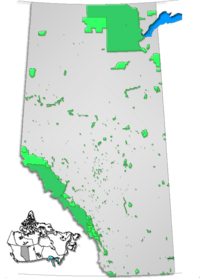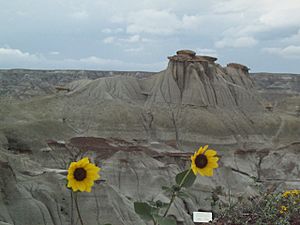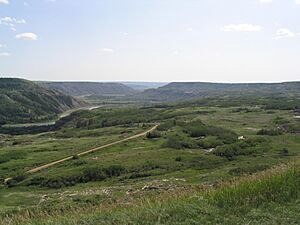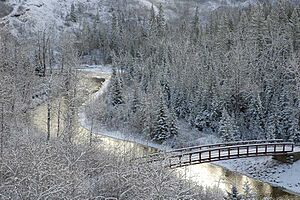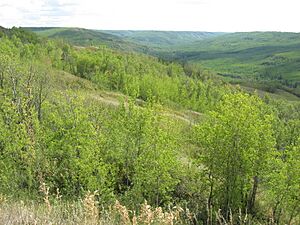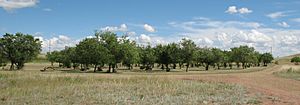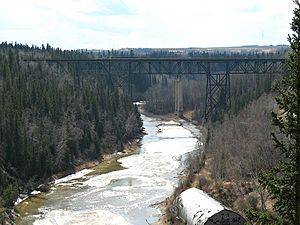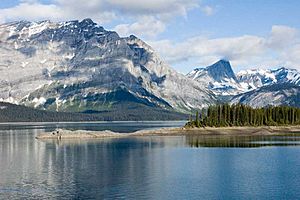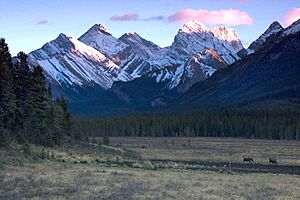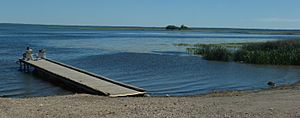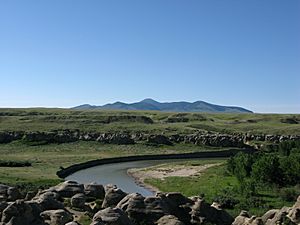List of protected areas of Alberta facts for kids
Quick facts for kids Alberta Parks |
||
|---|---|---|
| Type | Number | Area km2 (sq mi) |
| Provincial Parks | 76 | 2,214 km2 (855 sq mi) |
| Wildland Provincial Parks | 31 | 17,314 km2 (6,685 sq mi) |
| Provincial Recreation Areas | 208 | 899 km2 (347 sq mi) |
| Wilderness Areas | 3 | 1,010 km2 (390 sq mi) |
| Ecological Reserves | 15 | 268 km2 (103 sq mi) |
| Natural Areas | 139 | 1,299 km2 (502 sq mi) |
| Heritage Rangelands | 2 | 120 km2 (46 sq mi) |
| National Parks | 5 | 63,045 km2 (24,342 sq mi) |
| Total | 476 | 90,747 km2 (35,038 sq mi) |
Alberta is home to many amazing natural places! These special spots are called protected areas. They are managed by the Canadian or Alberta governments to keep them safe. These areas protect wildlife, plants, and important historical sites. About 60% of Alberta's land is public, but only some of it is formally protected. In total, protected areas cover about 90,700 km2 (35,000 sq mi) of Alberta. That's a huge amount of land set aside for nature!
Contents
Alberta's Special Protected Areas
Protected areas in Alberta are recognized in different ways. Some are famous around the world!
World Heritage Sites
Six places in Alberta are part of UNESCO's World Heritage Site list. These are places that are super important globally. They are recognized for their natural beauty or historical value.
- Canadian Rocky Mountain Parks (shared with British Columbia)
- Dinosaur Provincial Park
- Head-Smashed-In Buffalo Jump
- Waterton-Glacier International Peace Park (shared with Montana, United States)
- Wood Buffalo National Park (shared with Northwest Territories)
- Writing-on-Stone Provincial Park
UNESCO Biosphere Reserves
Alberta also has two UNESCO Biosphere Reserves. These are places where people try to live in a way that protects nature. They show how humans and nature can exist together.
- Waterton Biosphere Reserve (since 1979)
- Beaver Hills Biosphere Reserve (since 2016)
Parks Managed by the Canadian Government
The Canadian government looks after some of Alberta's biggest and most famous parks. These are called National Parks of Canada. They are managed by an organization called Parks Canada.
There are five National Parks in Alberta:
- Banff
- Elk Island
- Jasper
- Waterton Lakes
- Wood Buffalo
Some national parks used to exist but were later changed. For example, Buffalo National Park was delisted in 1947.
National Historic Sites
Parks Canada also manages some National Historic Sites of Canada. These are places that are important to Canada's history.
- Rocky Mountain House has a visitor center and offers tours.
- Frog Lake has outdoor signs explaining its history.
Other Federally Protected Areas
Suffield National Wildlife Area is another protected area. It is located within a military training base.
Parks Managed by the Alberta Government
The Alberta government protects many natural spaces. These are managed by Alberta Parks, which is part of the Ministry of Forestry, Parks and Tourism. They work to protect Alberta's beautiful landscapes.
There are seven main types of protected areas in Alberta:
- Ecological reserves: These areas offer the highest level of protection. They are for scientific research and education.
- Wilderness areas: These are wild places where nature is left untouched. You can only explore them on foot.
- Wildland provincial parks: These are large, wild areas for outdoor adventures like hiking and camping.
- Provincial parks: These are popular parks for recreation. They often have campgrounds and trails.
- Natural areas: These are smaller areas that protect specific natural features.
- Heritage rangelands: These areas protect important grasslands and their history.
- Provincial recreation areas: These are smaller areas for specific activities like boating or picnicking.
As of 2016, Alberta had:
- 76 provincial parks
- 32 wildland provincial parks
- 208 provincial recreation areas
- 15 ecological reserves
- 3 wilderness areas
- 139 natural areas
- 2 heritage rangelands
Sometimes, private companies help manage parts of these parks. They might help with things like keeping campgrounds tidy.
Wilderness Areas
Wilderness areas are the most strictly protected places. No building or development is allowed. You can only explore these areas by walking.
- Ghost River Wilderness Area
- Siffleur Wilderness Area
- White Goat Wilderness Area
- Willmore Wilderness Park
Examples of Provincial Parks
Alberta has many provincial parks, each with its own unique features. Here are just a few examples:
- Dinosaur Provincial Park: Famous for its dinosaur fossils and badlands.
- Fish Creek Provincial Park: A large urban park in Calgary, great for walking and biking.
- Peter Lougheed Provincial Park: A beautiful park in the Rocky Mountains, popular for hiking and camping.
- Writing-on-Stone Provincial Park: Known for its amazing rock formations and ancient rock art.
Other Protected Lands
Beyond the specific parks, about 60% of Alberta's land is public. This land is managed for different uses, including forestry and grazing. The Rocky Mountains Forest Reserve was created to protect forests in the mountains. There are also many provincial grazing reserves where cattle can graze.
See also
 In Spanish: Anexo:Áreas protegidas de Alberta para niños
In Spanish: Anexo:Áreas protegidas de Alberta para niños
- List of Canadian provincial parks
- List of National Parks of Canada


